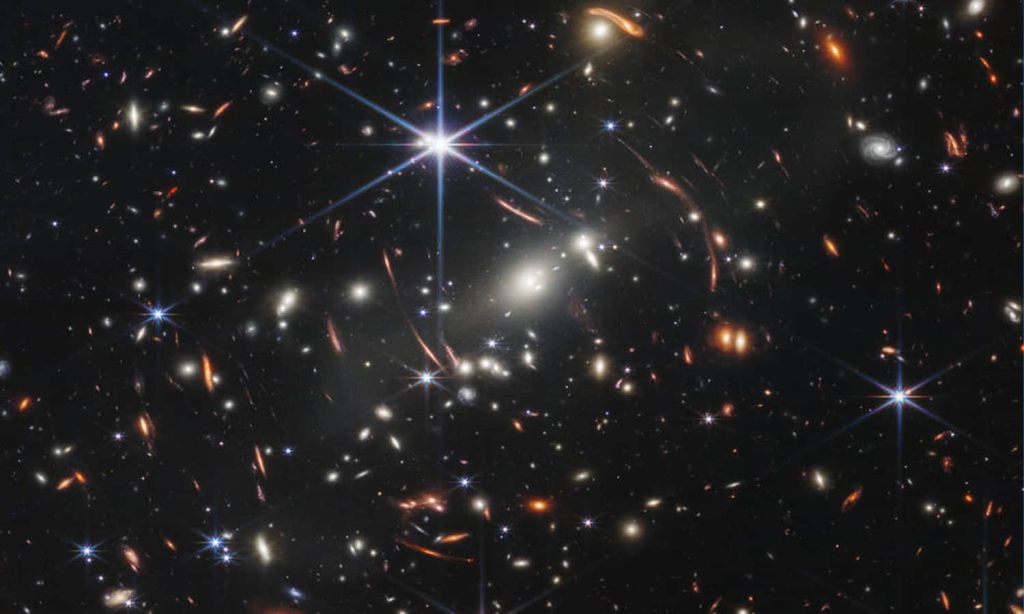The universe is 13.8 billion years old. Galaxies did not start forming until around 13 billion years ago. Now, thanks to the brand spanking new James Webb Telescope, we have full-colour images of those same galaxies from the distant past.
The image, above, is the deepest and most detailed view of the universe that humans have ever taken. The picture shows light from some of the first galaxies to have been created and is expected to reshape our understanding of how the universe was created.
The NASA image was unveiled by US President Joe Biden, during an event at the White House, who called it “historic” and said that it provided “a new window into the history of our universe.”
“When this image is shared with the world, it will be a historic moment for science and technology, for astronomy and space exploration, for America and all of humanity,” Biden said.
While it might look like some coloured splodges on a black background, the image is full of detailed information that scientists can use to learn about the way our universe was formed, how it’s been shaped, and even whether it might contain other forms of life.
“We’re looking back more than 13 billion years… and we’re going further… this is just the first image and since we know the universe is 13.8 billion years old, we’re going back almost to the beginning,” NASA administrator Bill Nelson said.
“It is going to be so precise you are going to see whether or not planets are habitable. And when you look at something as big as this we’re going to be able to answer questions that we don’t even know what the questions are yet.”
The newly launched James Webb Telescope cost US$10 billion to build and three space agencies 20 years to launch. Its capacity is more than double that of the Hubble space telescope’s and it gathers light information on the infrared spectrum as well as the visible.
The James Webb departed Earth at the start of the year and is positioned roughly 1.6 million kilometres beyond our planet’s orbit. As Biden described, it is equipped with a mirror lens 6.4 metres wide, a multi-layered sun shield the “size of a tennis court,” and 250,000 shutters, each one smaller than a grain of sand.
Sand seems to be the going comparison of the day, with Nelson explaining the image as: “if you held a grain of sand on the tip of your finger at arm’s length, that is the part of the universe that you’re seeing — just one little speck of the universe. And what you’re seeing there are galaxies. You’re seeing galaxies that are shining around other galaxies whose light has been bent. And you’re seeing just a small little portion of the universe”.
Gravitational Lensing
The James Webb telescope’s capabilities allow it to see something called ‘gravitational lensing’. In the picture above, you can see that galaxies and light sources appear stretched and distorted. This is because, as Einstein theorised, light, like mass, is also affected by the pull of gravity. Those light sources are warped in the image because very heavy objects, like galaxies, affect the trajectory of light’s journey to us through their gravitational pull.
Only incredibly powerful telescopes can see these effects and be able to witness that effect so clearly is expected to give us key insights.
What kind of insights? Well, we’re not exactly sure yet. As Nelson pointed out, there’s going to be so much information coming to us from this telescope about things we’ve not even yet begun to theorise that it’s going to take years to break it all down. We could well have new conceptions about physics, life, and how it all began.
This image is just the first of millions of planned shots that the telescope is set to send back to us.
Who Is James Webb, and Why Do People Want to Change the Telescope’s Name?
As you can probably work out, the telescope is named after James E Webb, NASA’s second administrator. Webb worked under the John F Kenney and Lyndon B Johnson administration and dealt with the Apollo 1 fire as well as getting NASA to the point where it could put a man on the moon for the first time.
He’s a hugely influential figure in the space administration, however, he’s got a pretty dubious reputation for having overseen the firings of queer people within NASA. As part of the so-called ‘lavender scare’ during the 1960s, many US government departments identified and removed employees that they suspected of being gay. Webb is argued to have been one of the heads of department who actively participated in these discriminatory sackings.
Scientists have long been petitioning NASA to remove his name from the telescope in response to his historical persecution of queer people and the new image from the telescope has reignited those calls.
NASA claim that they have found no evidence that Webb was directly involved in the purge of queer people from the organisation, however researchers say they’re ignoring the evidence.
Professor Chanda Prescod-Weinstein, a physicist at the University of New Hampshire, is one of the lead campaigners in removing Webb’s name from the telescope. She tweeted on Monday:
“As one of the people who has been leading the push to change the name, today feels bittersweet, I’m so excited for the new images and so angry at Nasa HQ. Nasa leadership has stubbornly refused to acknowledge that what is now public info about JW’s legacy means he does not merit having a great observatory named after him.”
Read more stories from The Latch and subscribe to our email newsletter.

